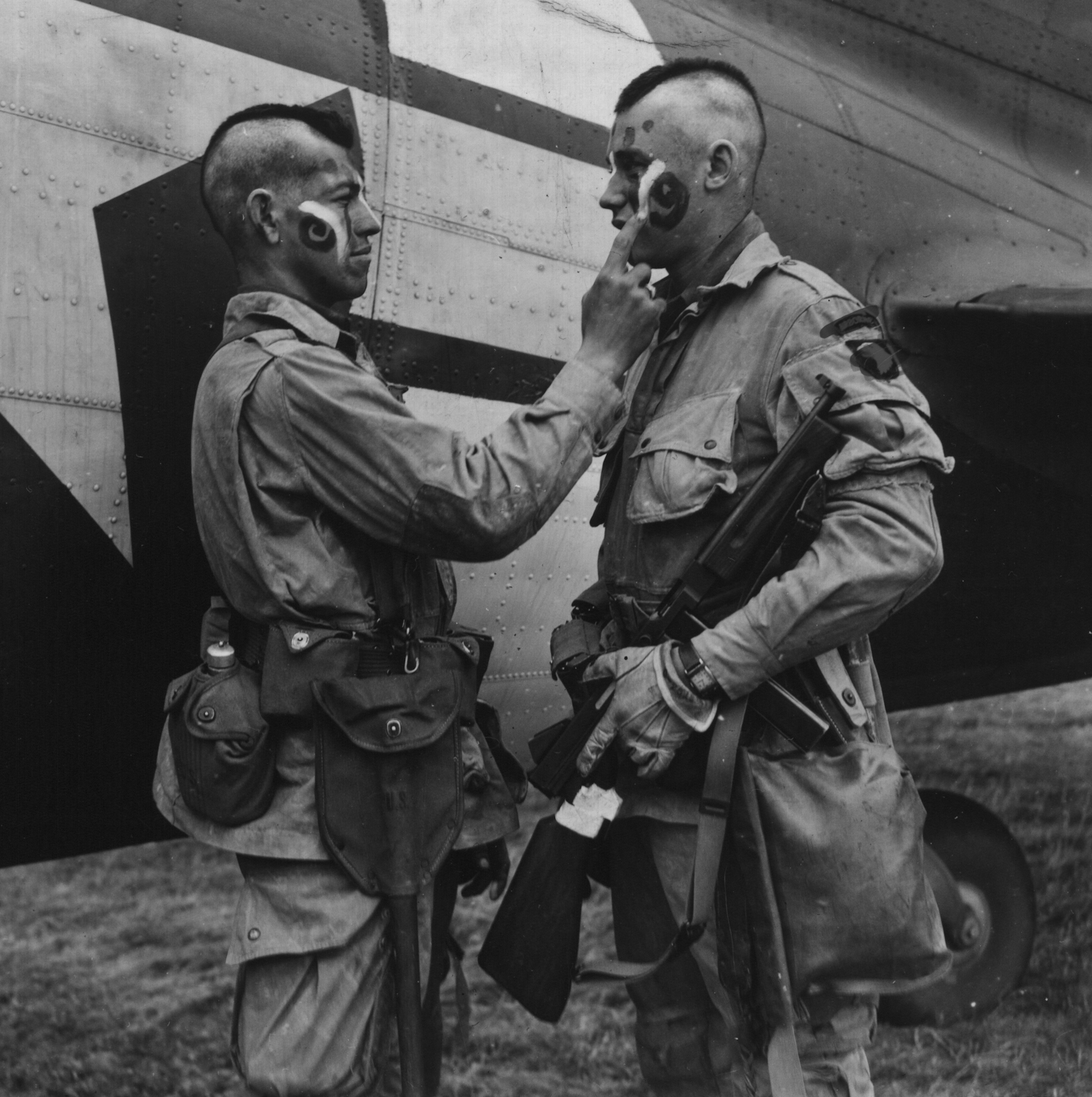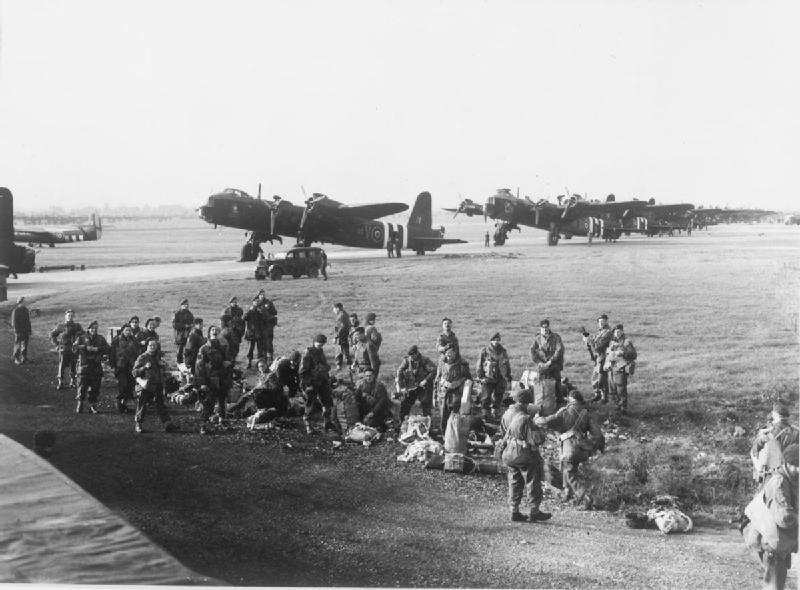|
Filthy Thirteen
The Filthy Thirteen was the name given to the 1st Demolition Section of the Regimental Headquarters Company of the 506th Parachute Infantry Regiment, 101st Airborne Division, of the United States Army, which fought in the European campaign in World War II. This unit was the inspiration for the 1965 book and 1967 film ''The Dirty Dozen''. History The 1st Demolition Section was assigned and trained as demolition saboteurs to destroy enemy targets behind the lines. Inspired by Sergeant Jake McNiece, the unit had a tremendous mission focus but their disregard for aspects of military discipline that did not contribute to the mission became the bane of their officers. The 13-man unit acquired the nickname the Filthy Thirteen while living in Nissen huts in England, refusing to bathe during the week in order to use their water ration for cooking game poached from the neighboring manor. Photos of the men wearing Native American–style " mohawks" and applying war paint to one another ... [...More Info...] [...Related Items...] OR: [Wikipedia] [Google] [Baidu] |
Paratrooper Applies War Paint 111-SC-193551cropped
A paratrooper is a military parachutist—someone trained to parachute into a military operation, and usually functioning as part of an airborne force. Military parachutists (troops) and parachutes were first used on a large scale during World War II for troop distribution and transportation. Paratroopers are often used in surprise attacks, to seize strategic objectives such as airfields or bridges. Overview Paratroopers jump out of airplanes and use parachutes to land safely on the ground. This is one of the three types of "forced entry" strategic techniques for entering a theater of war; the other two being by land and by water. Their tactical advantage of entering the battlefield from the air is that they can attack areas not directly accessible by other transport. The ability of air assault to enter the battlefield from any location allows paratroopers to evade emplaced fortifications that guard from attack from a specific direction. The possible use of paratroopers ... [...More Info...] [...Related Items...] OR: [Wikipedia] [Google] [Baidu] |
Pathfinder (military)
In military organizations, a pathfinder is a specialized soldier inserted or dropped into place in order to set up and operate drop zones, pickup zones, and helicopter landing sites for airborne operations, air resupply operations, or other air operations in support of the ground unit commander. Pathfinders first appeared in World War II, where they served with distinction, and continue to serve an important role in today's modern armed forces, providing commanders with the option of flexibly employing air assets. History United Kingdom During the Second World War small groups of parachute soldiers were formed into pathfinder units, to parachute ahead of the main force. Their tasks were to mark the drop zones (DZ) or landing zones (LZ), set up radio beacons as a guide for the aircraft carrying the main force and to clear and protect the area as the main force arrived. The units were formed into two companies to work with the two British airborne divisions created during th ... [...More Info...] [...Related Items...] OR: [Wikipedia] [Google] [Baidu] |
True (magazine)
''True'', also known as ''True, The Man's Magazine'', was published by Fawcett Publications from 1937 until 1974. Known as ''True, A Man's Magazine'' in the 1930s, it was labeled ''True, #1 Man's Magazine'' in the 1960s. Petersen Publishing took over with the January 1975, issue. It was sold to Magazine Associates in August 1975, and ceased publication shortly afterward. High adventure, sports profiles and dramatic conflicts were highlighted in articles such as "Living and Working at Nine Fathoms" by Ed Batutis, "Search for the Perfect Beer" by Bob McCabe and the uncredited "How to Start Your Own Hunting-Fishing Lodge." In addition to pictorials ("Iceland, Unexpected Eden" by Lawrence Fried) and humor pieces ("The Most Unforgettable Sonofabitch I Ever Knew" by Robert Ruark), there were columns, miscellaneous features and regular concluding pages: "This Funny Life," "Man to Man Answers," "Strange But True" and "''True'' Goes Shopping." Editors Donald Ayres "Bill" Williams became as ... [...More Info...] [...Related Items...] OR: [Wikipedia] [Google] [Baidu] |
Dundalk Eagle
The ''Dundalk Eagle'' is a newspaper serving Dundalk, Maryland. Founded in 1969 by Kimbel E. Oelke, it was one of the biggest family-owned weekly newspapers in Maryland before its acquisition by Adams Publishing Group Adams Publishing Group LLC (APG) is a company that provides publishing services, including newspapers, periodicals, and website publishing in the United States. Its corporate headquarters is located in Coon Rapids, Minnesota. Mark Adams, the son ... in 2015. References External links Official Website Newspapers published in Maryland {{Maryland-newspaper-stub ... [...More Info...] [...Related Items...] OR: [Wikipedia] [Google] [Baidu] |
Jack Womer
Jack Neitz Womer (18 June 1917 – 28 December 2013) was a decorated American World War II veteran and a member of the Filthy Thirteen who was known for his World War II exploits. Womer was a member of the 29th Ranger Battalion, the 101st Airborne Division and the 506th Parachute Infantry Regiment (506th PIR). Throughout his service in the 101st Airborne Division, Womer was assigned to the Demolitions Platoon of the 506th PIR Regimental Headquarters Company in the section known officially as the First Demolitions Section and nicknamed the Filthy Thirteen. Known for his astuteness in battle, which he attributed to his rigorous training by British Commandos while in the 29th Ranger Battalion, Womer was never injured in combat. Womer was among the members of the Filthy Thirteen who parachuted into Normandy, France, on 6 June 1944 as part of the Normandy Invasion ( Operation Overlord). He was the only one that remained in the Filthy Thirteen and participated in Operation Market-G ... [...More Info...] [...Related Items...] OR: [Wikipedia] [Google] [Baidu] |
Prisoner Of War
A prisoner of war (POW) is a person who is held captive by a belligerent power during or immediately after an armed conflict. The earliest recorded usage of the phrase "prisoner of war" dates back to 1610. Belligerents hold prisoners of war in custody for a range of legitimate and illegitimate reasons, such as isolating them from the enemy combatants still in the field (releasing and repatriating them in an orderly manner after hostilities), demonstrating military victory, punishing them, prosecuting them for war crimes, exploiting them for their labour, recruiting or even conscripting them as their own combatants, collecting military and political intelligence from them, or indoctrinating them in new political or religious beliefs. Ancient times For most of human history, depending on the culture of the victors, enemy fighters on the losing side in a battle who had surrendered and been taken as prisoners of war could expect to be either slaughtered or enslaved. Ear ... [...More Info...] [...Related Items...] OR: [Wikipedia] [Google] [Baidu] |
Wounded In Action
Wounded in Action (WIA) describes combatants who have been wounded while fighting in a combat zone during wartime, but have not been killed. Typically, it implies that they are temporarily or permanently incapable of bearing arms or continuing to fight. Generally, the Wounded in Action are far more numerous than those killed. Common combat injuries include second and third degree burns, broken bones, shrapnel wounds, brain injuries, spinal cord injuries, nerve damage, paralysis, loss of sight and hearing, post-traumatic stress disorder (PTSD), and limb loss. For the U.S. military, becoming WIA in combat generally results in subsequent conferral of the Purple Heart, because the purpose of the medal itself (one of the highest awards, military or civilian, officially given by the American government) is to recognize those killed, incapacitated, or wounded in battle. NATO's definitions Wounded in action A battle casualty other than '' killed in action'' who has incurred an injur ... [...More Info...] [...Related Items...] OR: [Wikipedia] [Google] [Baidu] |
Jack Agnew
Jack may refer to: Places * Jack, Alabama, US, an unincorporated community * Jack, Missouri, US, an unincorporated community * Jack County, Texas, a county in Texas, USA People and fictional characters * Jack (given name), a male given name, including a list of people and fictional characters with the name * Jack (surname), including a list of people with the surname * Jack (Tekken), multiple fictional characters in the fighting game series ''Tekken'' * Jack the Ripper, an unidentified British serial killer active in 1888 * Wolfman Jack (1938–1995), a stage name of American disk jockey Robert Weston Smith * New Jack, a stage name of Jerome Young (1963-2021), an American professional wrestler * Spring-heeled Jack, a creature in Victorian-era English folklore Animals and plants Fish *Carangidae generally, including: **Almaco jack **Amberjack **Bar jack **Black jack (fish) **Crevalle jack **Giant trevally or ronin jack ** Jack mackerel ** Leather jack **Yellow jack *Coho salm ... [...More Info...] [...Related Items...] OR: [Wikipedia] [Google] [Baidu] |
Operation Varsity
Operation Varsity (24 March 1945) was a successful airborne forces operation launched by Allied troops that took place toward the end of World War II. Involving more than 16,000 paratroopers and several thousand aircraft, it was the largest airborne operation in history to be conducted on a single day and in one location. ''Varsity'' was part of Operation Plunder, the Anglo-American-Canadian assault under Field Marshal Bernard Montgomery to cross the northern Rhine River and from there enter Northern Germany. ''Varsity'' was meant to help the surface river assault troops secure a foothold across the Rhine River in Western Germany by landing two airborne divisions on the eastern bank of the Rhine near the village of Hamminkeln and the town of Wesel. The plans called for the dropping of two divisions from U.S. XVIII Airborne Corps, under Major General Matthew B. Ridgway, to capture key territory and to generally disrupt German defenses to aid the advance of Allied ground forces. ... [...More Info...] [...Related Items...] OR: [Wikipedia] [Google] [Baidu] |
17th Airborne Division (United States)
The 17th Airborne Division, "The Golden Talons", was an airborne infantry division of the United States Army during World War II, commanded by Major General William M. Miley. It was officially activated as an airborne division in April 1943 but was not immediately sent to a combat theater, remaining in the United States to complete its training. During this training process, the division took part in several training exercises, including the Knollwood Maneuver, in which it played a vital part in ensuring that the airborne division remained as a military formation in the U.S. Army. As such it did not take part in the first two large-scale airborne operations conducted by the Allies, Operation Husky and Operation Neptune, transferring to Britain only after the end of Operation Overlord. When the division arrived in Britain, it came under the command of Maj. Gen. Matthew B. Ridgway's XVIII Airborne Corps, a part of Maj. Gen. Lewis H. Brereton's First Allied Airborne Army, but wa ... [...More Info...] [...Related Items...] OR: [Wikipedia] [Google] [Baidu] |
Netherlands
) , anthem = ( en, "William of Nassau") , image_map = , map_caption = , subdivision_type = Sovereign state , subdivision_name = Kingdom of the Netherlands , established_title = Before independence , established_date = Spanish Netherlands , established_title2 = Act of Abjuration , established_date2 = 26 July 1581 , established_title3 = Peace of Münster , established_date3 = 30 January 1648 , established_title4 = Kingdom established , established_date4 = 16 March 1815 , established_title5 = Liberation Day (Netherlands), Liberation Day , established_date5 = 5 May 1945 , established_title6 = Charter for the Kingdom of the Netherlands, Kingdom Charter , established_date6 = 15 December 1954 , established_title7 = Dissolution of the Netherlands Antilles, Caribbean reorganisation , established_date7 = 10 October 2010 , official_languages = Dutch language, Dutch , languages_type = Regional languages , languages_sub = yes , languages = , languages2_type = Reco ... [...More Info...] [...Related Items...] OR: [Wikipedia] [Google] [Baidu] |





